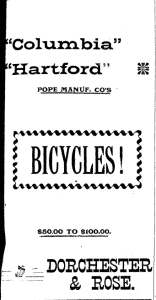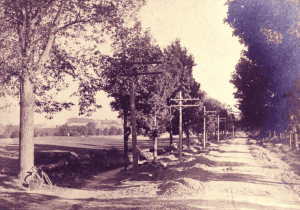Bicycles and Cinder Paths
By John Marks, Curator of Collections
January is a good month for going down historical rabbit holes. I won’t explain how I arrived at it, but my current rabbit hole is cinder paths, or side paths, for bicycles in the 1890s.
In 1887 the safety bicycle – equal-size wheels, chain drive, and brakes – was introduced in America. It opened cycling to people who were scared of riding the high wheel “penny farthing” bicycles. However, finding a good place to ride was difficult.
Dirt roads were dusty ruts when dry and a muddy mess when wet. The June 5, 1894
Geneva Advertiser pointed out that pedestrians outnumbered wagons two to one on roads. They recommended making paths, so folks didn’t have to walk in the road.
It is an easy and simple thing to make [a] footpath, rounding it up a little so as to shed the water…From Rochester clear to Charlotte they have good walks, mostly made from coal ashes and cinders – they call it a cinder path. Such sidewalks should be made on every highway leading to Geneva for at least six miles, if not to make them on every main road and cross road.
The Advertiser felt the need to further explain cinder paths in April of 1895.
“It appears that all do not understand what a cinder-path is. It is nothing more than a sidewalk made of coal cinders, firmly packed and sufficiently rounded to shed the water, and constructed along the highway. They are made especially for bicycling, for which purpose they are good as concrete or flag….There has been some talk of constructing one from Geneva to Cayuga Lake Park, by the river road through South Waterloo and Seneca Falls.”
Readers born in the 20th century will remember high school tracks being made of cinders. Like me, some of you may still have some cinders embedded in a knee or hand from falling on the track in gym class.
By 1896 Geneva was part of the national bicycle craze. An April newspaper noted, “Sixteen bicycles were sold in Geneva yesterday. Wheels seem to be the only things now going in town.” The Advertiser of the same month said that Dorchester & Rose Hardware “sells more than a hundred wheels every year. [Owner E.G. Dorchester] says there are now fully 600 wheels in use here – he thinks nearer 750.”
In May, Geneva cyclists, or wheelmen as they were called, organized the Lakeside Wheelmens Club. Men and women alike were welcome. Being at least eighteen years of age and having good moral character were the only membership requirements.
Two years after it was mentioned in the Advertiser, the May 5, 1897 Geneva Daily Times reported a firm plan for building a local cinder path. “The Waterloo wheelmen have agreed to build two miles leaving five miles for the Geneva club to look after…. The present intention is to go down Lake Street to the Outlet of Seneca Lake, thence on the south side of the Seneca River to Waterloo, where it will connect with the one already built [from Waterloo to Cayuga Lake].” The Lakeside Club’s 130 members would be taxed $2 each toward construction.
In June the Geneva Gazette reported that “the Geneva-Waterloo cinder path in course of construction is advancing rather slowly from this end owing to delay in securing ashes. The Waterloo end of the path had been completed. It is five feet wide and is said to the best piece of cinder path in this vicinity.” A month later, the Advertiser noted, “The Geneva-Waterloo cinder path is making very slow progress, and unless matters change will not be finished this year.” A year later, the same paper said that Geneva’s section of the path was unfinished, reflecting poorly on Geneva.
While Geneva struggled to support cinder paths, the idea took hold in New York State…which will be my topic for February.
This article was brought to you in part by our supporters. Be our partner in telling Geneva’s stories by becoming a Historic Geneva supporter.



John, this is very interesting! I look forward to your February article!
Hi John, I wonder if Vince Scalise ever knew this. Mr. Scalise was responsible for the path that now connects Geneva to Waterloo along the Seneca canal.
Very interesting article. Thankyou